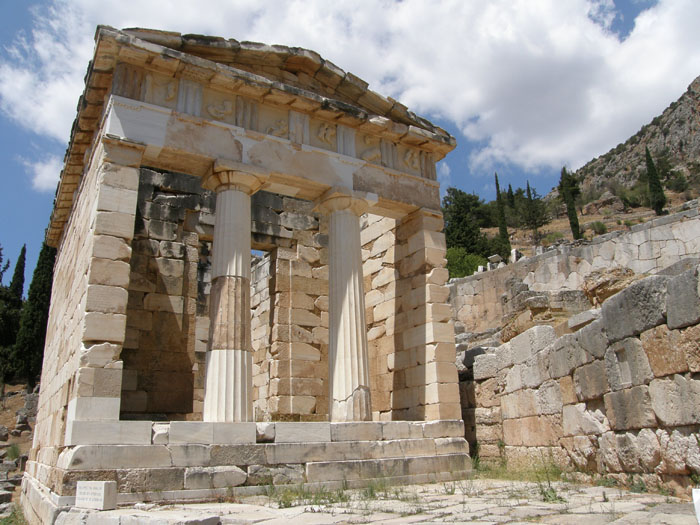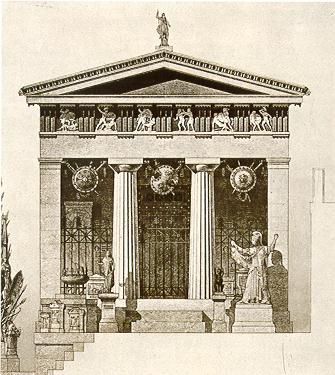Athenian Treasury
The Treasury of the Athenians at Delphi was used to store votive offerings of the city of Athens. It was up to the Sacred Way, which, with the oracle of Delphi, led to the temple of Apollo. For the built of Parian marble, and provided with spätarchaischem image jewelry treasure house (Greek thesaurus ) there is no exact date. On the basis of style and architectural Compare it is assumed that it was built in the period 510-480 BC in general.
Building and decorative paintings
Built in the shape of Ante Temple after the Doric order building consisting of a cella and pronaos two-column as an input, possessed in its original state a gable roof with acroterium. The acroterium is however no longer obtain. The thesaurus measures in plan 6.62 × 9.69 m and reaches a height of 7.60 m.
According to the Doric order of the pictorial decoration was distributed to the pediments and metopes on. On the metopes deeds of the Greek heroes Theseus and Hercules were shown. The Athenian Theseus theme was South and probably depicted on the metopes of the well on the east side, and could be viewed by visitors to the Shrine of the Sacred Way from. The metopes of the north and west side showed, however, Heracles. Many reliefs of the metopes and the largest part of the gable figures today are severely damaged or even lost, so a full reconstruction of the ancient image composition is very difficult and controversial.
Interpretation
The establishment of the treasury in the prestigious and influential of Apollo sanctuary at Delphi was to demonstrate the importance and power of Athens in comparison to the other Greek city-states ( poleis ). Thus, besides Athens maintained a large number of other cities in Delphi their own treasuries. As an example, of the 30 excavated Thesauroi, in this case the BC Built by 570 treasure house of Sikyonians be mentioned, which was also located at the Sacred Way to the Temple of Apollo and was said to be very richly furnished. In this context, the before 525 BC dated Treasury of Siphnier to be mentioned.
Different approaches for a more detailed interpretation of the Athenian treasure house narrow the possible establishment of a further period.
- Firstly, the Treasury is interpreted that it was donated as a sign of success in Athens under Cleisthenes 508/507 BC reforms carried out by Delphi.
- Another interpretation approach provides the victory of the Athenians under Miltiades against the Persians under Darius I. at the battle of Marathon in 490 BC The dedication of the treasury at the Apollo sanctuary was therefore out of gratitude at the happy outcome of the battle. Pausanias, in this respect, that the construction of the Persian spoils of war was financed. But probably wrong here Pausanias, who erroneously the inscription of one of the battle of Marathon dedicated Weihgeschenkes then assigned the treasure house.
Research history and re-establishment
The Treasury of the Athenians was excavated in 1893 by French archaeologists led Théophile Homolles and first published in 1894 by the Fund Homolle. Due to the number of the found components, about two-thirds of the original building mass, it was decided to rebuild the destroyed treasure house. In the years 1903-1906, this could be implemented centennial celebration of the City of Athens, under the direction of the French archaeologist Albert Tournaire and Joseph Replat. The missing parts were replaced with limestone blocks and architecturally important places, like the musicians and columns by blocks of marble pentelischen. 1933, the architecture of the building was published by Jean Audiat. In 1957 the publication of the architectural sculpture by Pierre de La Coste - Messeliere.








